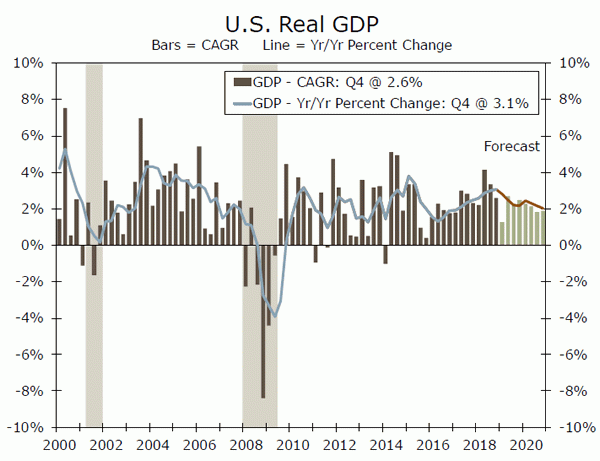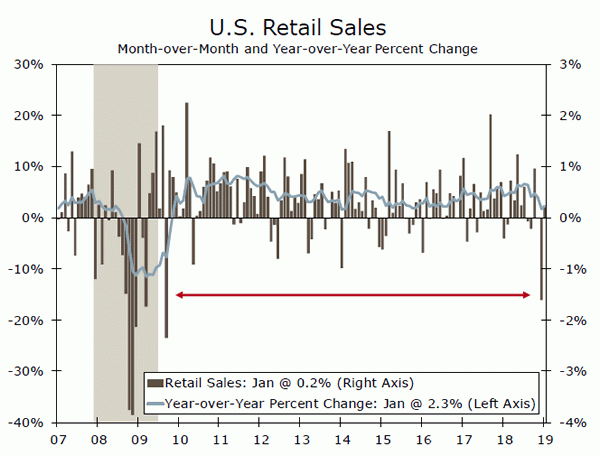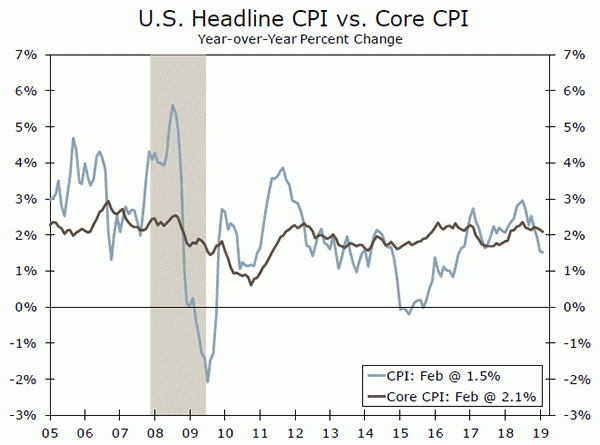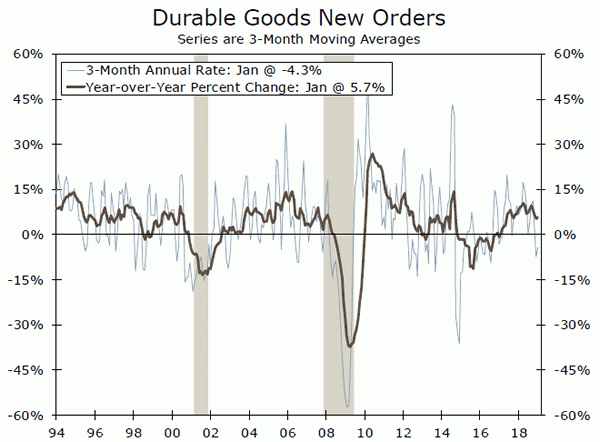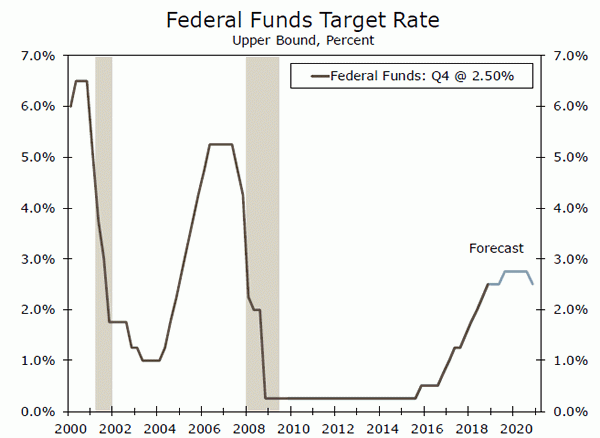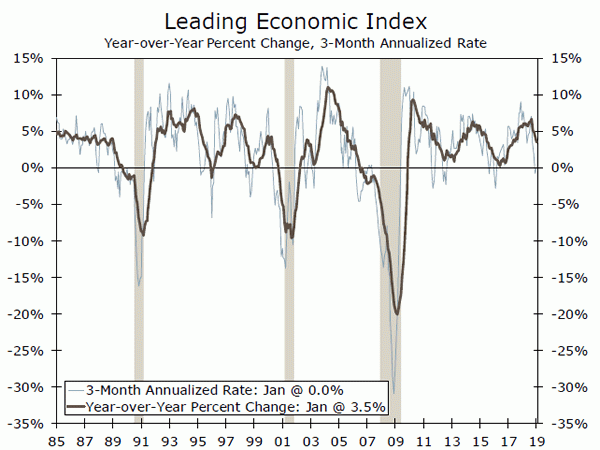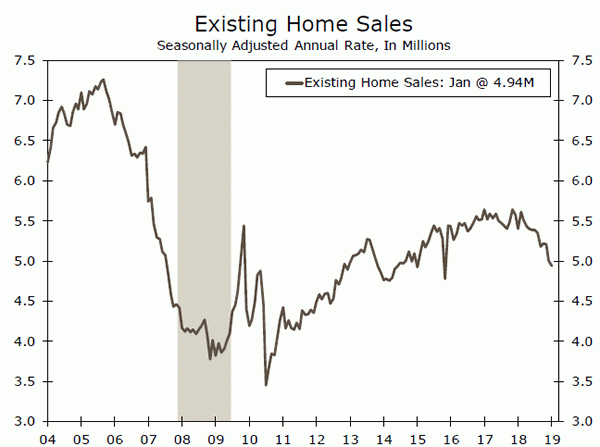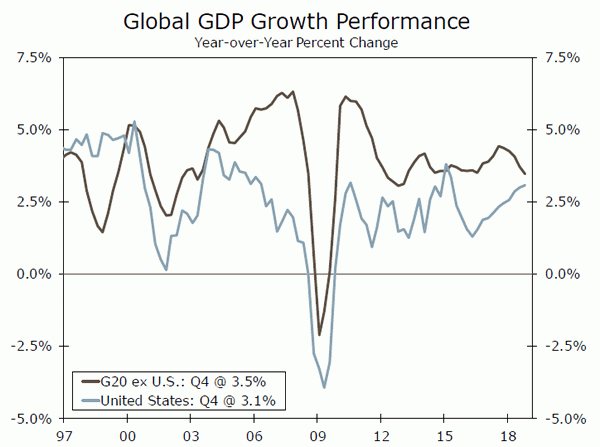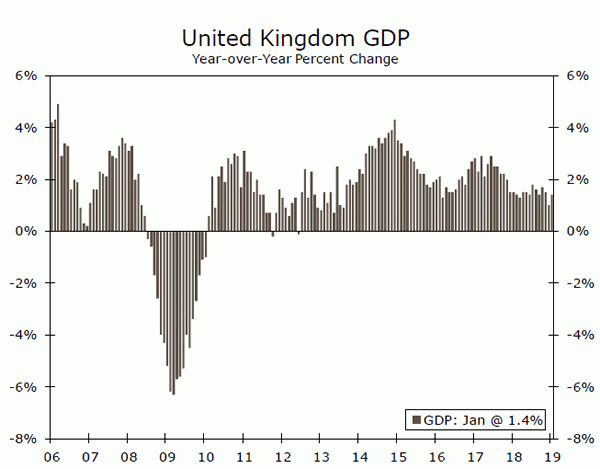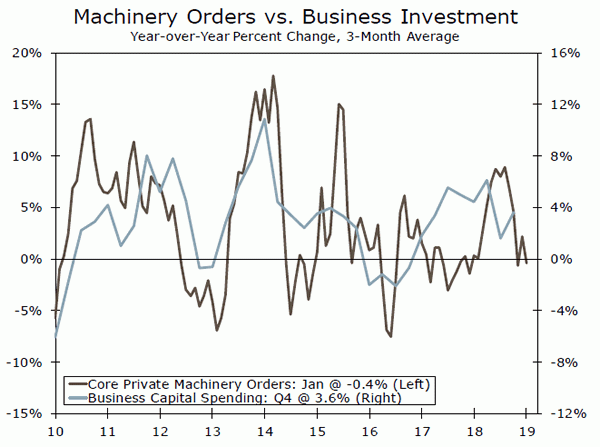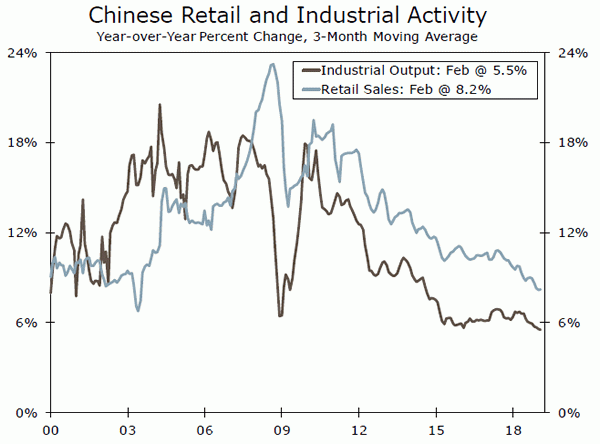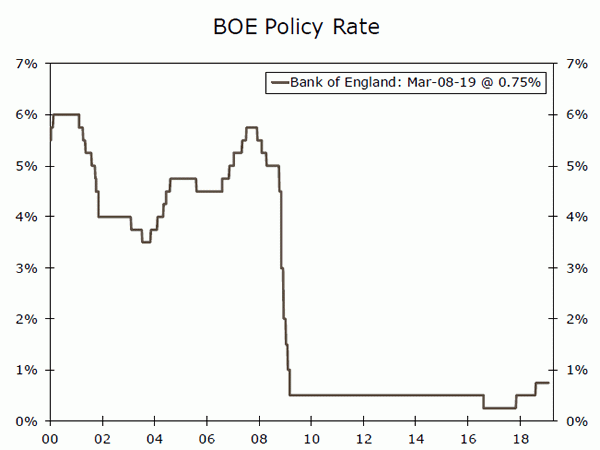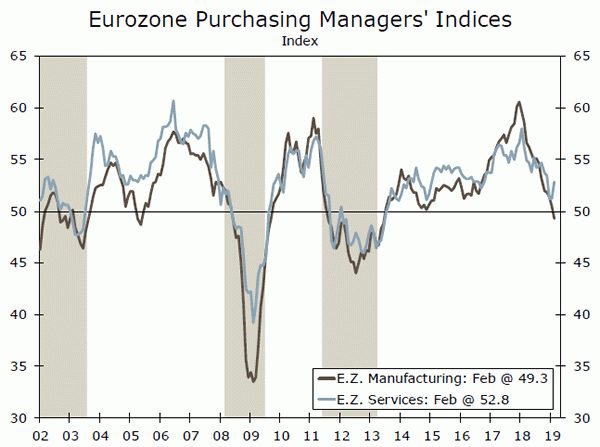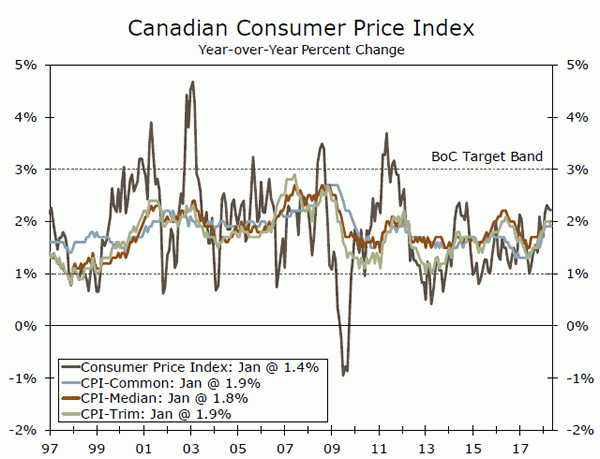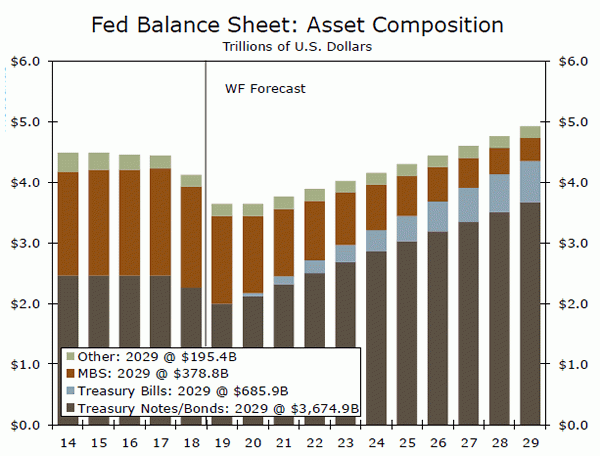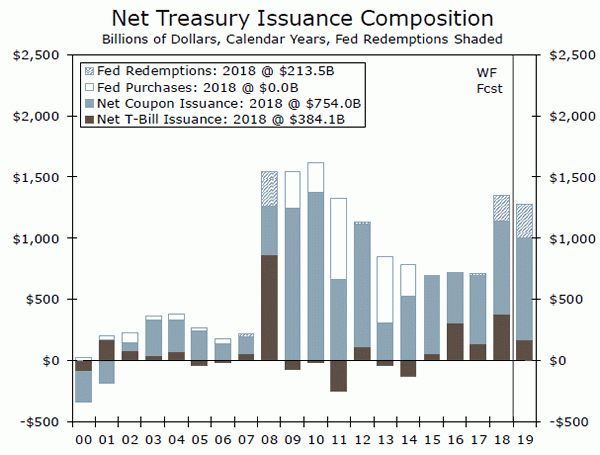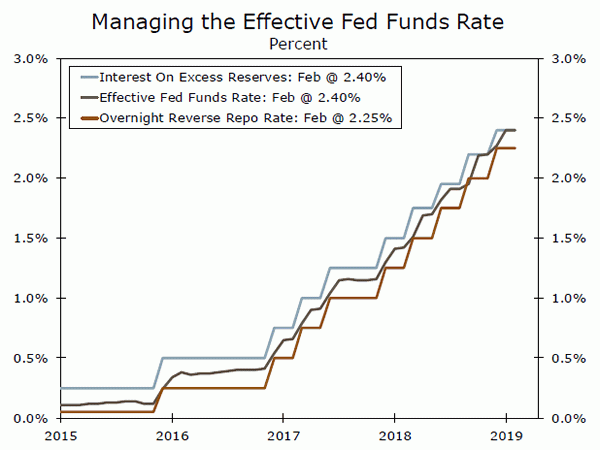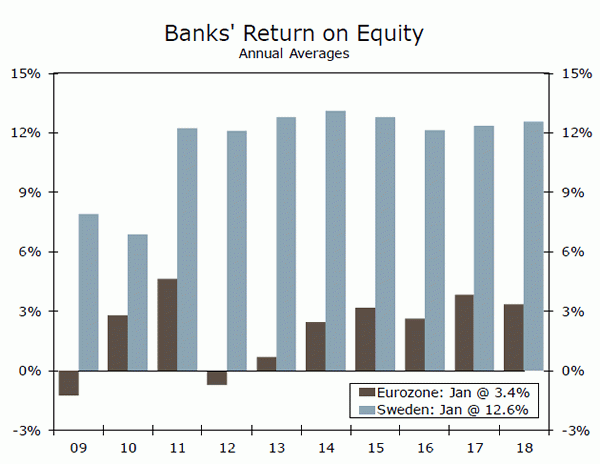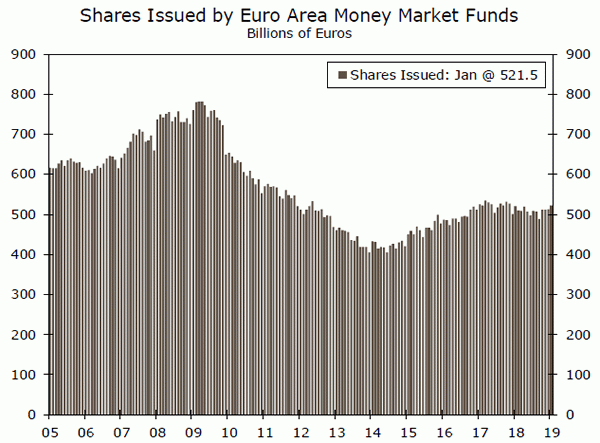U.S. Review
Economic Data Reinforce Fed Patience
- Several indicators released this week signaled a moderation in the pace of economic growth, and provided further reinforcement for patience from the Fed on further monetary policy tightening.
- Retail sales rebounded in January, but the gain wasn’t enough to completely wash out the weak readings in December, suggesting a slow start to the year for consumer spending.
- Prices continue to increase only modestly, and with core inflation measures at or near the Fed’s target of 2%, increased risk of a break-out to the upside remains limited.
Economic Data Reinforce Fed Patience
Several indicators released this week signaled a moderation in the pace of U.S. economic growth, and provided further reinforcement for patience from the Fed on further monetary policy tightening.
The week opened with the January retail sales report, which showed a bounce-back in consumer spending after what was the worst month for retailers since the Great Recession. Stripping away volatile components—food, autos, gas and building materials—the control group measure fared even worse in December, declining 2.3%, or the largest monthly decline since 2000. Given that this measure is a good proxy for the goods portion of personal consumption expenditures in the GDP report, the 1.1% rebound in January calmed fears of a prolonged retrenchment in spending.
That said, while we suspect the weak December was due to transitory factors, Q1 spending is dented. December, a key shopping period for consumers, was plagued by a market sell-off, which cramped consumer confidence and reduced household wealth. But, with financial markets having regained all of the ground they gave up in December, and confidence measures trending higher, spending doesn’t appear to be falling off a cliff, but it will be weaker in the first quarter.
Prices data for February remained more or less in check. The Consumer Price Index edged up in February, but lower energy prices over the past year have held down the headline index on a year-over-year basis. With core inflation running at a 2.1% annualized pace over the past three months and on a year-overyear basis, the underlying price trend remains at the Fed’s target, suggesting there is little need (from an inflation perspective) for it to move swiftly on further rate hikes. In last week’s payroll report, we learned that average hourly earnings hit a new cycle high in February, but such heating labor costs have only modestly passed through to consumer inflation. Stronger productivity growth and historically high profit margins present some scope for companies to eat higher labor costs, and suggest inflation is unlikely to get out of hand anytime soon.
Producer prices also remain subdued, rising 0.1% in February, and 1.9% on a year-over-year basis. Through the volatility, core PPI inflation moderated to 2.3%, year-over-year. The recent trend here has remained consistent with that seen from consumer prices, and further affirms that a renewed gain in inflation remains minimal.
The hard data for durable goods were fairly positive, considering the volatile readings on new orders from the ISM manufacturing index in recent months. Core orders and core shipments both notched 0.8% gains over the month. The headline was pushed up by a large gain in aircraft orders—non defense and defense aircraft orders were up 13.1%. Despite volatility in the orders component, uncertainty remains on how durable goods could be impacted in coming months due to the grounding of the Boeing 737 MAX aircraft. Please see our short special report concerning this topic for more detail.
U.S. Outlook
FOMC Meeting • Wednesday
After increasing the fed funds rate each quarter in 2018, the FOMC declared in January that it will be “patient” with future adjustments. We see little reason for the FOMC to have altered its stance since then. Financial conditions have eased further, but a number of other “cross-currents” Chair Powell noted have not abated. Core inflation has eased up a touch and inflation expectations have edged down. The labor market remains tight, but initial jobless claims and payrolls suggest it is improving at a slower pace. Headwinds from overseas persist, with signs of global growth slowing further.
Next week’s meeting will include updated economic projections. We anticipate estimates for GDP growth and inflation will be revised down a bit. The Fed’s markedly more dovish stance in January also points to participants’ projections for the fed funds rate being lowered from two hikes this year to one, and possibly even none. For potential changes to the balance sheet, see the Interest Rate Watch.
Previous: 2.25-2.50% Wells Fargo: 2.25-2.50% Consensus: 2.25-2.50%
Leading Economic Index • Thursday
The Conference Board’s Leading Economic Index highlights how the U.S. economy has lost some momentum in recent months. The index has virtually stalled since September, including an unchanged reading in January. We expect to see a modest increase in February, however. More building permits, higher equity prices, stronger capital goods orders and a rebound in consumer expectations should all add to the index. Partially offsetting those gains, however, look to be fewer hours worked in the manufacturing sector alongside a pullback in the ISM new orders index.
Even with a gain in February, the LEI points to slowing growth in the economy as fiscal stimulus wanes and monetary policy support is removed. The slowdown is consistent with the Fed taking its time in deciding its next move.
Previous: 0.0% Wells Fargo: 0.1% Consensus: 0.1%
Existing Home Sales • Friday
Existing home sales rolled over in 2018, but we expect to see the start of a modest rebound in February. Mortgage rates have come down about 50 bps since last November, helping buyers on the affordability front. Home price growth has also been moderating, while stronger wage growth has narrowed the gulf between costs and income. Already there are signs of demand picking back up. Pending home sales, which lead existing home sales by one to two months, jumped 4.6% in January, while mortgage purchase applications have risen since the fourth quarter.
Winter is a slow season for the housing market, which generates the possibility of seasonal factors exaggerating February’s print. As a result, we do not expect this month’s existing home sales to have much bearing on the Fed in isolation, but will offer another clue as to how much higher interest rates over the past two years have affected the housing market.
Previous: 4.90M Wells Fargo: 5.08M Consensus: 5.10M
Global Review
Still Slow Going for Global Growth
- This week’s economic news remained consistent with the narrative of a slow-motion global expansion. Chinese activity data for early 2019 were mildly soft in tone, while Japan’s activity data were also subdued overall. Q4-GDP figures for the G20 were released and showed that outside of the United States, international economic growth remains on a steadily slowing trend (see chart on right).
- U.K. GDP jumped in January, reversing its December fall, but it is unclear how long that growth pace will persist. The U.K. parliament voted this week to delay the Brexit date, extending uncertainty and likely pushing back Bank of England hikes.
U.K. Starts Strong in 2019, But Will it Continue?
After a subdued finish to 2018, the U.K. economy started 2019 on a stronger footing. This week’s January GDP figures showed the economy grew 0.5% month-over-month, more than reversing the 0.4% decline from December. The key services sector—which accounts for the majority of U.K. economic activity—rose 0.3%, while the monthly increase in GDP was also helped by a 0.6% gain in industrial output and a 2.8% gain in construction output. On an annual basis, GDP growth firmed to 1.4% year-over-year in January, from 1.0% in December.
However, we believe it is unlikely the U.K. economy will sustain this strong pace of growth through the early part of this year. In fact, just this week U.K. lawmakers voted to request an extension to the deadline for the U.K. to formally leave the European Union. It’s not yet assured whether that extension will be approved by the other European Union countries, and, in any event, it simply prolongs the current uncertainty. As a result we have pushed back the timing of our Bank of England rate hike by one quarter, to Q3- 2019 and Q1-2020.
Bank of Japan Keeps Monetary Policy on Hold
The Bank of Japan once again held monetary policy steady this week, keeping its policy rate at -0.10% and maintaining a target for 10-year Japanese government bond yields of around 0%, with an unchanged tolerance band. In fact, with Japan’s economic backdrop still relatively subdued we no longer expect the central bank will adjust monetary policy in a less accommodative direction in the second quarter, although we still expect the government to proceed with its consumption tax increase in October as scheduled.
The mixed nature of Japan’s activity data offers a good indication of why we believe the central bank will keep monetary policy on hold. Japan’s core private machinery orders slumped 5.4% month-over-month in January, not exactly an encouraging sign for business capital spending (see middle chart). The tertiary industry index—a measure of service sector activity—did rise 0.4% in January, but that did not fully reverse the 0.5% decline from December. With CPI inflation still well short of the Bank of Japan’s goal, we expect monetary policy to stay on hold for some time.
China: Hard Data, Hard Landing?
The first “hard” activity data for China relating to 2019 were released this week, and although they point to a continued slowdown they do not, in our view, point to a Chinese “hard landing”. January-February retail sales rose 8.2% year-over-year, matching the consensus forecast and in line with the annual growth rate from December 2018. Industrial output for the first two months of the year rose 5.3%, not only a downside surprise, but also below the 5.7% year-over-year gain from December.
The relative stability in retail sales along with the gradual slowdown in industrial output suggests that China’s economic slowdown should remain orderly, especially given continued monetary and fiscal policy support. For calendar 2019, we expect a modest slowdown in China’s GDP growth to 6.2%.
Global Outlook
Bank of England Decision • Thursday
After a couple of 25 bps rate increases between late 2017 and mid-2018, the Bank of England has since been firmly on hold as it waits for uncertainty surrounding the U.K.’s exit from the European Union to dissipate. Following this week’s political developments that uncertainty has not yet lifted, and is still not clear whether a Brexit deal will be reached and approved by the end-March deadline. Given the unsettled environment, we expect the Bank of England to once again hold its policy interest rate at 0.75% at this month’s meeting.
Although U.K. Q4-GDP disappointed with growth of just 0.2% quarter-over-quarter (not annualized), some monthly economic indicators have been more resilient. Next week also sees January labor market data, with average weekly earnings expected to rise 3.2% year-over-year. February retail sales should fall 0.4% month-over-month after its January gain, while core CPI inflation should have remained close to target in February.
Previous: 0.75% Wells Fargo: 0.75% Consensus: 0.75%
Eurozone PMIs • Friday
The persistent slowdown of the Eurozone economy has attracted the attention of investors and policymakers. The economy grew at just a 0.7% annualized pace in H2-2018, with manufacturing especially soft, and the service sector also subdued. Against that backdrop the European Central Bank made a dovish shift at its March announcement, saying interest rates would remain at low levels for longer and announcing a new round of targeted long term loans.
In this environment, the Eurozone PMI surveys are being particularly closely scrutinized for clues on the path of the economy. February was a mixed bag, with the manufacturing PMI falling further to 49.3, but the services PMI rose for the first time in five months to 52.8. The March figures could offer insight on whether that was temporary relief or a sustained improvement—the consensus expects the services PMI to ease to 52.7, while the manufacturing PMI is expected to rise to 49.5.
Previous: 49.3 (Manufacturing), 52.8 (Services) Consensus: 49.5 (Manufacturing), 52.7 (Services)
Canadian CPI • Friday
Canadian CPI inflation has been relatively benign in recent months, a trend that we believe will continue with the February reading. We expect headline inflation to firm slightly to 1.6% year-over-year, comfortably within the Bank of Canada’s 1%-3% target range. Meanwhile, measures of core inflation are likely to remain just below 2%, where they have been for the past several months.
Although the Bank of Canada seems comfortable with recent inflation outcomes, economic growth developments have likely been more concerning. Q4-GDP rose just 0.4% (annualized) and, at its March announcement, the central bank said the slowdown was more broad-based than expected, and that a period of “below neutral” interest rates was warranted. Next week sees further activity data in the form of January retail sales, coming after sales showed a month-over-month fall in both November and December. We have pushed back our forecast of Bank of Canada hikes, with an initial increase now seen in the third quarter of this year.
Previous: 1.4% Wells Fargo: 1.6% Consensus: 1.4% (Year-over-Year)
Point of View
Interest Rate Watch
Fed Balance Sheet Comes into View
In addition to the updated economic and dot plot projections expected from the FOMC next Wednesday, policymakers may also provide some additional color on the outlook for the Fed’s balance sheet.
Thus far, much of the focus has been on when and at what size the balance sheet unwind will conclude. Based on our analysis and reading of the tea leaves, we believe this has already been more or less established. While the exact timing is unclear, we believe the Fed will likely stop shrinking its balance sheet at some point later this year.
However, there are still several outstanding questions that need answers. First, after the unwind comes to an end, will the Fed immediately begin growing its balance sheet again? Over time, the Fed’s balance sheet should grow in line with its major liabilities, namely currency in circulation and bank reserves. That said, some participants have suggested that the Fed could hold the size of the balance sheet steady for a period of time, allowing them to patiently monitor whether reserves have truly reached a level that is no larger than needed to implement monetary policy “efficiently and effectively”.
Second, the composition of the balance sheet going forward remains unclear. Will the Fed continue to allow mortgage-backed securities (MBS) to roll-off? And if so, at what pace? If MBS continue to roll-off, as we expect, the Fed will need to begin buying a healthy chunk of Treasury securities, both to replace MBS and to account for organic balance sheet growth. This then raises yet another question: where along the Treasury curve will the Fed buy? In our view, the most market-neutral approach would be to buy in proportion to how the Treasury is issuing on a net basis, which at the moment is roughly 30% T-bills and 70% notes and bonds.
These questions are in addition to several other issues under consideration at the Fed, such as potentially introducing a standing repo facility or adopting a new main policy rate, such as the overnight bank funding rate (a close relative of the fed funds rate). While we doubt all of these issues will be addressed in full at next week’s meeting, there will likely be plenty to digest.
Credit Market Insights
China Still Buying U.S. CRE
China remained a net buyer of U.S. commercial properties in 2018, despite a popular narrative of rapid divesture amidst an escalating bilateral trade dispute and broader restrictions on outbound Chinese capital. To be sure, Chinese sales of American properties shot up over 200% in 2018 to $8.1 billion, and purchases fell over 50%. Yet with purchases still totaling $11.2 billion, China remained a net investor. The United States remains the favored destination for Chinese investment, despite government efforts to regulate and divert the flow of funds elsewhere. The economic outperformance of the United States relative to the rest of the developed world—over the past couple of years as well the expectation for 2019—and ongoing strength in CRE fundamentals have kept demand for properties buoyant. Moreover, the relative stability of the United States amidst slowing growth in the Eurozone and Japan and a trade-exacerbated secular slowdown in China bolster the attractiveness of U.S. CRE as a store of value.
For now, China continues to buy U.S. properties. Fears of widespread disposals, potentially as one front of a trade war, have not been fully realized. Rapid Chinese selling of U.S. Treasuries causing yields to spike has also not occurred. A potential trade deal, still not quite in the offing, should loom over any potential cross-border investment decision for the foreseeable future.
Topic of the Week
Could the Fed Go Negative?
Our forecast for the U.S. economy does not currently include a recession any time in the near future, but when the next downturn comes around, Fed policymakers are likely to reassess their toolkit for stimulating economic activity. Could negative interest rate policy (NIRP) become part of that toolkit in the next downturn?
Central banks in other major developed countries have implemented NIRP in recent years, including the Eurozone (i.e., the ECB), Denmark, Japan, Sweden and Switzerland. In general, these countries have seemingly had mixed success with negative rates, but the purported downside effects have also not been all that significant.
Let us start with the effects of NIRP on the banking sector. In theory, negative interest rates could be passed on to consumers and lead to large-scale deposit flight, but, in practice, deposits have been stable in countries employing NIRP. Meanwhile, bank profitability and lending activity do not seem to have been meaningfully hampered by the implementation of negative rates in other countries. Money market mutual funds (MMMFs) have also seemingly not been significantly harmed or disrupted, despite concerns over the theoretical impact of negative rates on fund inflows. Finally, NIRP has in general not seemingly led to bubble-like behavior in financial markets, and in areas where asset prices have become frothier amid negative interest rates, authorities have responded with policies to discourage speculative activity and contain price appreciation.
In short, NIRP does not seem to have the degree of negative impact on the economy that theory suggests. Yet, the efficacy of negative rates in other countries is far from clear, as economies in the Eurozone, Japan and Switzerland that have implemented negative rates continue to struggle with lackluster rates of economic growth and lingering deflationary concerns. Thus, the Fed may be hesitant to implement NIRP unless the next downturn is particularly severe, and, moreover, policymakers may employ other policies (such as QE) in conjunction with NIRP to jumpstart the economy.




